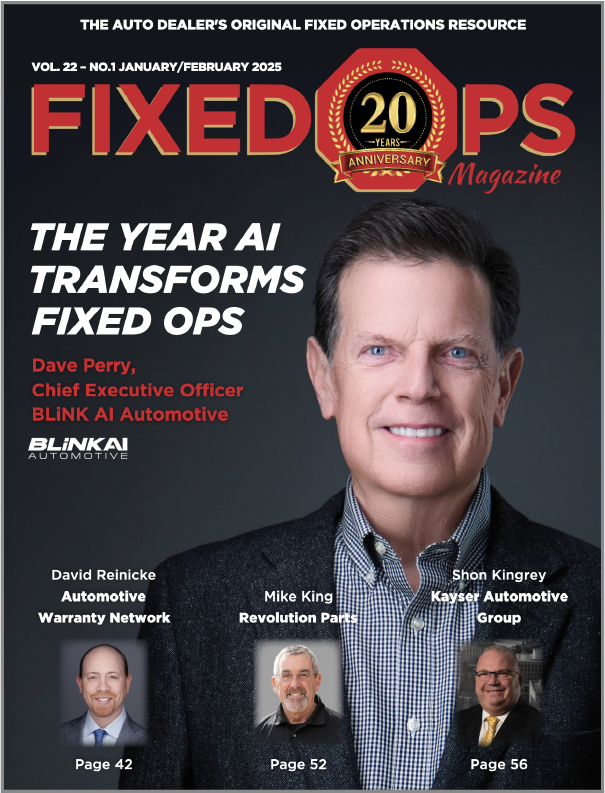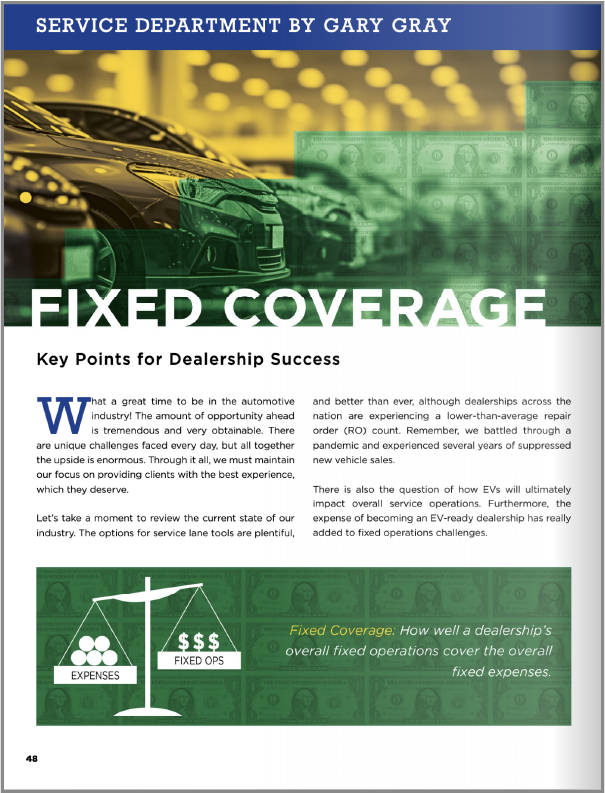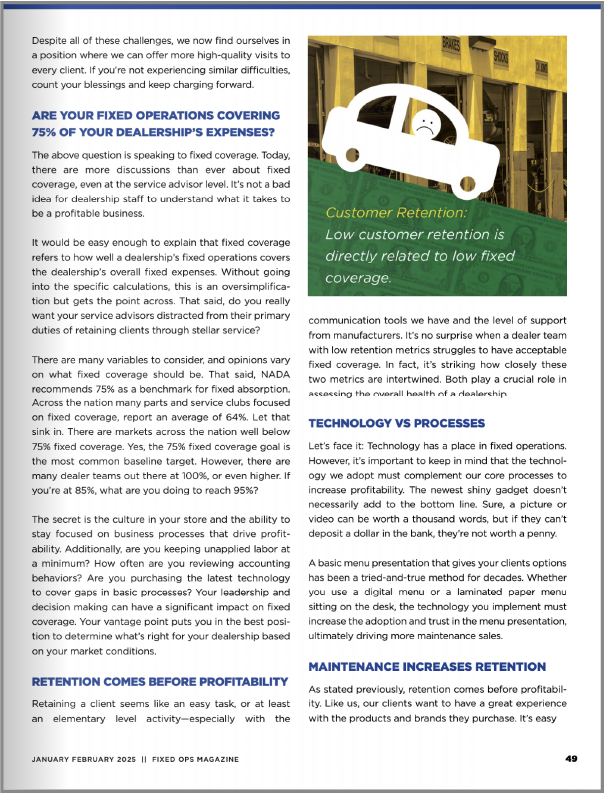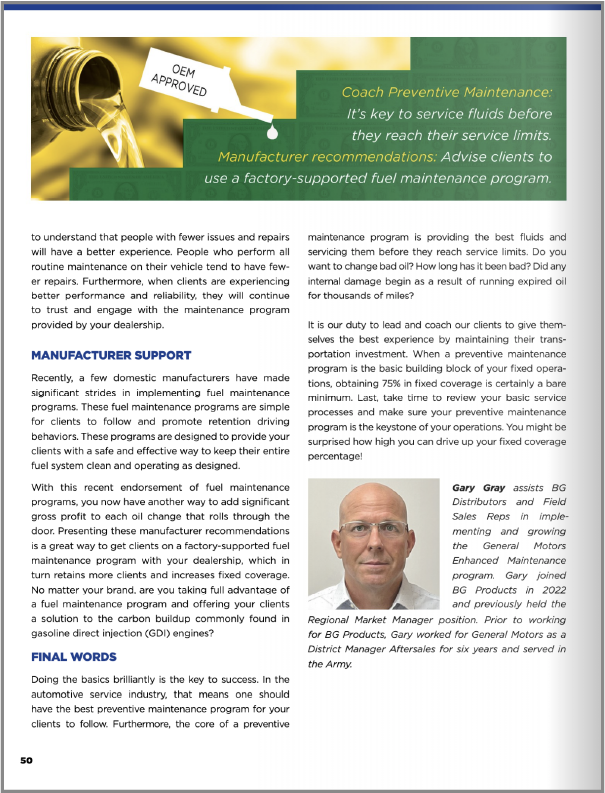Gary Gray | BG Manager of Distributor Field Support–OEM Programs
What a great time to be in the automotive industry! The amount of opportunity ahead is tremendous and very obtainable. There are unique challenges faced every day, but all together the upside is enormous. Through it all, we must maintain our focus on providing clients with the best experience, which they deserve.
Let’s take a moment to review the current state of our industry. The options for service lane tools are plentiful, and better than ever, although dealerships across the nation are experiencing a lower-than-average repair order (RO) count. Remember, we battled through a pandemic and experienced several years of suppressed new vehicle sales.
There is also the question of how EVs will ultimately impact overall service operations. Furthermore, the expense of becoming an EV-ready dealership has really added to fixed operations challenges. Despite all of these challenges, we now find ourselves in a position where we can offer more high-quality visits to every client. If you’re not experiencing similar difficulties, count your blessings and keep charging forward.
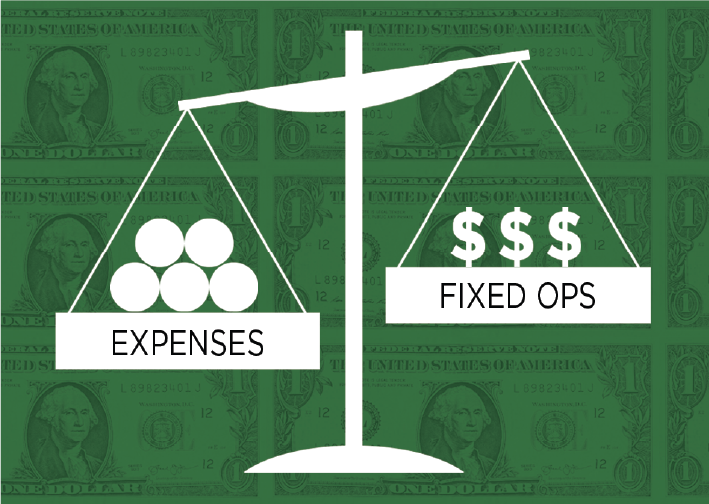
Are your Fixed Operations covering 75% of your dealership’s expenses?
The above question is speaking to fixed coverage. Today, there are more discussions than ever about fixed coverage, even at the service advisor level. It’s not a bad idea for dealership staff to understand what it takes to be a profitable business.
It would be easy enough to explain that fixed coverage refers to how well a dealership’s fixed operations covers the dealership’s overall fixed expenses. Without going into the specific calculations, this is an oversimplification but gets the point across. That said, do you really want your service advisors distracted from their primary duties of retaining clients through stellar service?
There are many variables to consider, and opinions vary on what fixed coverage should be. That said, NADA recommends 75% as a benchmark for fixed absorption. Across the nation many parts and service clubs focused on fixed coverage, report an average of 64%. Let that sink in. There are markets across the nation well below 75% fixed coverage. Yes, the 75% fixed coverage goal is the most common baseline target. However, there are many dealer teams out there at 100%, or even higher. If you’re at 85%, what are you doing to reach 95%?
The secret is the culture in your store and the ability to stay focused on business processes that drive profitability. Additionally, are you keeping unapplied labor at a minimum? How often are you reviewing accounting behaviors? Are you purchasing the latest technology to cover gaps in basic processes? Your leadership and decision making can have a significant impact on fixed coverage. Your vantage point puts you in the best position to determine what’s right for your dealership based on your market conditions.
Retention Comes Before Profitability
Retaining a client seems like an easy task, or at least an elementary level activity—especially with the communication tools we have and the level of support from manufacturers. It’s no surprise when a dealer team with low retention metrics struggles to have acceptable fixed coverage. In fact, it’s striking how closely these two metrics are intertwined. Both play a crucial role in assessing the overall health of a dealership.
Technology vs Processes
Let’s face it: Technology has a place in fixed operations. However, it’s important to keep in mind that the technology we adopt must complement our core processes to increase profitability. The newest shiny gadget doesn’t necessarily add to the bottom line. Sure, a picture or video can be worth a thousand words, but if they can’t deposit a dollar in the bank, they’re not worth a penny.
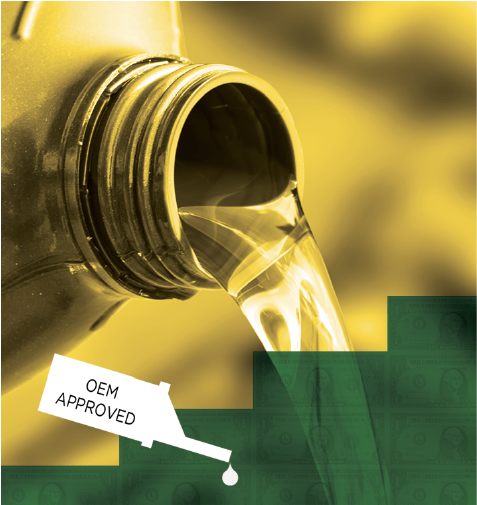
A basic menu presentation that gives your clients options has been a tried-and-true method for decades. Whether you use a digital menu or a laminated paper menu sitting on the desk, the technology you implement must increase the adoption and trust in the menu presentation, ultimately driving more maintenance sales.
Maintenance Increases Retention
As stated previously, retention comes before profitability. Like us, our clients want to have a great experience with the products and brands they purchase. It’s easy to understand that people with fewer issues and repairs will have a better experience. People who perform all routine maintenance on their vehicle tend to have fewer repairs. Furthermore, when clients are experiencing better performance and reliability, they will continue to trust and engage with the maintenance program provided by your dealership.
Manufacturer Support
Recently, a few domestic manufacturers have made significant strides in implementing fuel maintenance programs. These fuel maintenance programs are simple for clients to follow and promote retention driving behaviors. These programs are designed to provide your clients with a safe and effective way to keep their entire fuel system clean and operating as designed.
With this recent endorsement of fuel maintenance programs, you now have another way to add significant gross profit to each oil change that rolls through the door. Presenting these manufacturer recommendations is a great way to get clients on a factory-supported fuel maintenance program with your dealership, which in turn retains more clients and increases fixed coverage. No matter your brand, are you taking full advantage of a fuel maintenance program and offering your clients a solution to the carbon buildup commonly found in gasoline direct injection (GDI) engines?
Final Words
Doing the basics brilliantly is the key to success. In the automotive service industry, that means one should have the best preventive maintenance program for your clients to follow. Furthermore, the core of a preventive maintenance program is providing the best fluids and servicing them before they reach service limits. Do you want to change bad oil? How long has it been bad? Did any internal damage begin as a result of running expired oil for thousands of miles?It is our duty to lead and coach our clients to give themselves the best experience by maintaining their transportation investment. When a preventive maintenance program is the basic building block of your fixed operations, obtaining 75% in fixed coverage is certainly a bare minimum. Last, take time to review your basic service processes and make sure your preventive maintenance program is the keystone of your operations. You might be surprised how high you can drive up your fixed coverage percentage!

About the Author
Gary Gray assists BG Distributors and Field Sales Reps in implementing and growing the General Motors Enhanced Maintenance program. Gary joined BG Products in 2022 and previously held the Regional Market Manager position. Prior to working for BG Products, Gary worked for General Motors as a District Manager Aftersales for six years and served in the Army.


